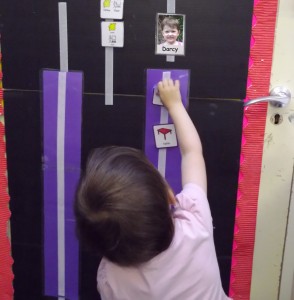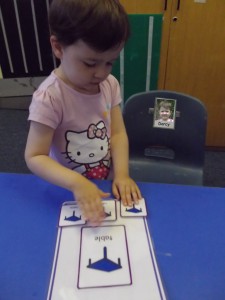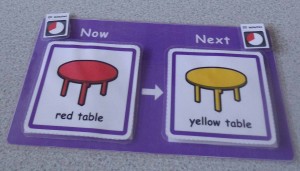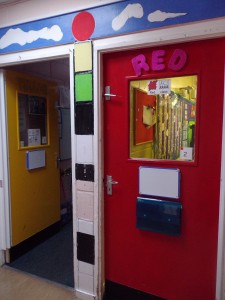For many teachers coming to the end of the summer holidays now is the time to start preparing for the new academic year. With that in mind we turn to author and teacher Adele Devine who in this brand new blog demonstrates how developing a colour coding system can make for a more comfortable learning environment, especially for early learners with Autism.
Through the classroom door
Transitioning into class can be a big hurdle for a child with autism. They have no idea what will happen beyond that door and the ‘unknown’ triggers alarm bells. We must also factor in some of the sensory issues, which often partner autism.
Turn up the volume of everything so that it is way above ‘uncomfortable’. Unfamiliar voices echo and what is that tidal wave sound? Is there a toilet flushing? The lighting seems drastically different – flickering as it does in horror scenes, building a frightening atmosphere. Clothing that felt fine before has become itchy, sticky and hot. The child may not be able communicate or make sense of these nightmare feelings. They realise there is no going back, but moving forwards suddenly seems overwhelming.
Show them the way
Preparing visuals to explain our expectations can help make everyday transitions seem more achievable. We must try to avoid the child reaching that overwhelmed state by paving each step with a visual support. Matching photos and symbols can give the child a task to focus on. The visual clarifies our expectations and reduces the need for complex language.
Visuals help the child feel safer and more in control.
Provide individual schedules

The child enters the classroom with a clear idea of what they should do first. They match their photo to the one at the top of their personal schedule.
We must make sure schedules are placed somewhere prominent within the child’s reach.
Next the child removes the first symbol from their schedule.
We teach the child to do this by gently guiding them and providing hand over hand support.
For example, they might first remove the blue table symbol and if so they will transition to the blue table from the top of their schedule.
Using transition boards

On the blue table there is a transition board with other ‘blue table’ symbols. The child places their symbol on the board.
There is a photo on the back of the chair indicating where the child could sit. They may not choose to sit. That is okay. They can learn to sit later… Right now we want them to feel safe, in control and that they are on the right track.
At the blue table you can set up an activity for the child to do, this should have a clear structure so the child knows the expectation. They should be given hand over hand help with learning a new task so that it does not frustrate or overwhelm them. Showing the child will be more helpful than a verbal explanation. Do not do the task for the child over and over, instead reduce your support each time and allow them to build their independence.
When the blue table activity is ‘finished’ the child is given their photo. They return to the schedule to match it and check what is next.
Using symbols, schedules and transition boards reduces the need for too many verbal instructions, helps the child transition and promotes independence.
A visual link can be created through colour. The individual schedule is purple, the symbols and the transition board are outlined in purple. The class timetable is also backed in purple. The hope is that the child may start to make a connection between their individual schedule and the class timetable.

The class timetable
A child may use a ‘Now and Next’ or ‘First and Then’ schedule to break down the expectations. These schedules are also backed in purple.

Now and Next schedule
Using a colour code for schedules, timetables, now and next boards and transition boards helps create a category. Children with autism are often very good at sorting by category, tuning into colours, shapes and patterns, but they can have difficulty generalising.
The colour purple creates a category for schedules. When the child wants to know ‘what we are going to do next’ they look for purple. We use the child’s strengths for categorising to create a stepping stone towards generalising.
Visual structure can bring order to chaos and help set the child with autism up to succeed.
Adele Devine is the author of Colour Coding for Learners with Autism available through Jessica Kingsley Publishers

The book is fantastic, clear, easy to follow and we will be using it this year.
Brilliant!
Thank you.
i am a parent of a 7yr old high function autist.he is in grade 2 in a public sped school here in the pilippines.i hope we can get a copy of this so we can let hos teacher use it to benefit other kids also…kids that have no proper access to therapies or even diagnosis of nueroped.thamk you..